
- CN 62-1070/P
- ISSN 1000-694X
- Bimonthly 1981

Journal of Desert Research ›› 2024, Vol. 44 ›› Issue (4): 111-125.DOI: 10.7522/j.issn.1000-694X.2024.00003
Previous Articles Next Articles
Fanrui Bu( ), Ying Liu, Xueyong Zou, Chunlai Zhang
), Ying Liu, Xueyong Zou, Chunlai Zhang
Received:2023-10-28
Revised:2024-01-05
Online:2024-07-20
Published:2024-08-29
CLC Number:
Fanrui Bu, Ying Liu, Xueyong Zou, Chunlai Zhang. Vegetation sustainability in relation to water resources in typical sandy areas of eastern China[J]. Journal of Desert Research, 2024, 44(4): 111-125.
Add to citation manager EndNote|Ris|BibTeX
URL: http://www.desert.ac.cn/EN/10.7522/j.issn.1000-694X.2024.00003
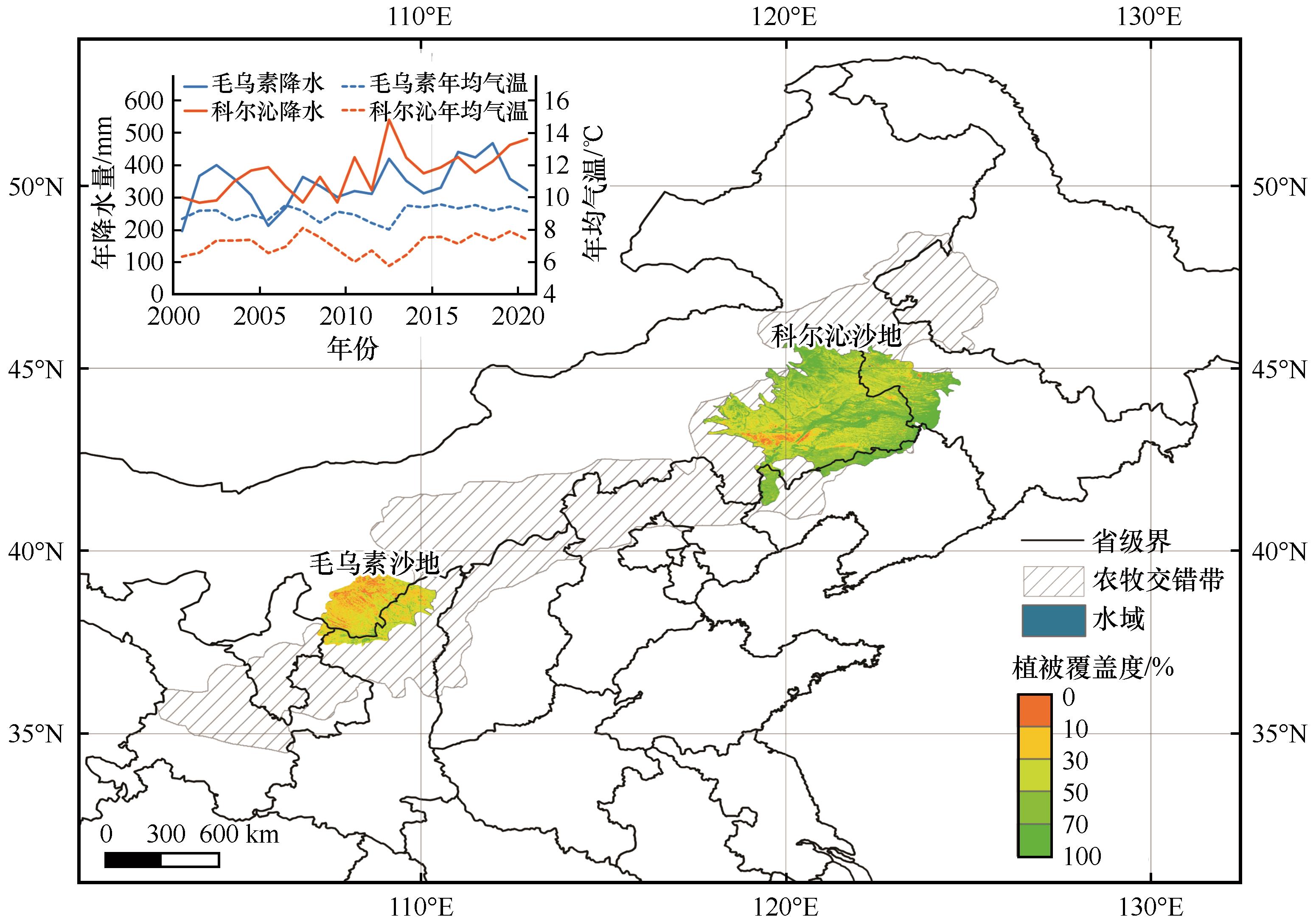
Fig.1 The location of the study areas, multi-year average vegetation coverage in the growing season (VCave) and time series of precipitation (P) and temperature during 2000-2020
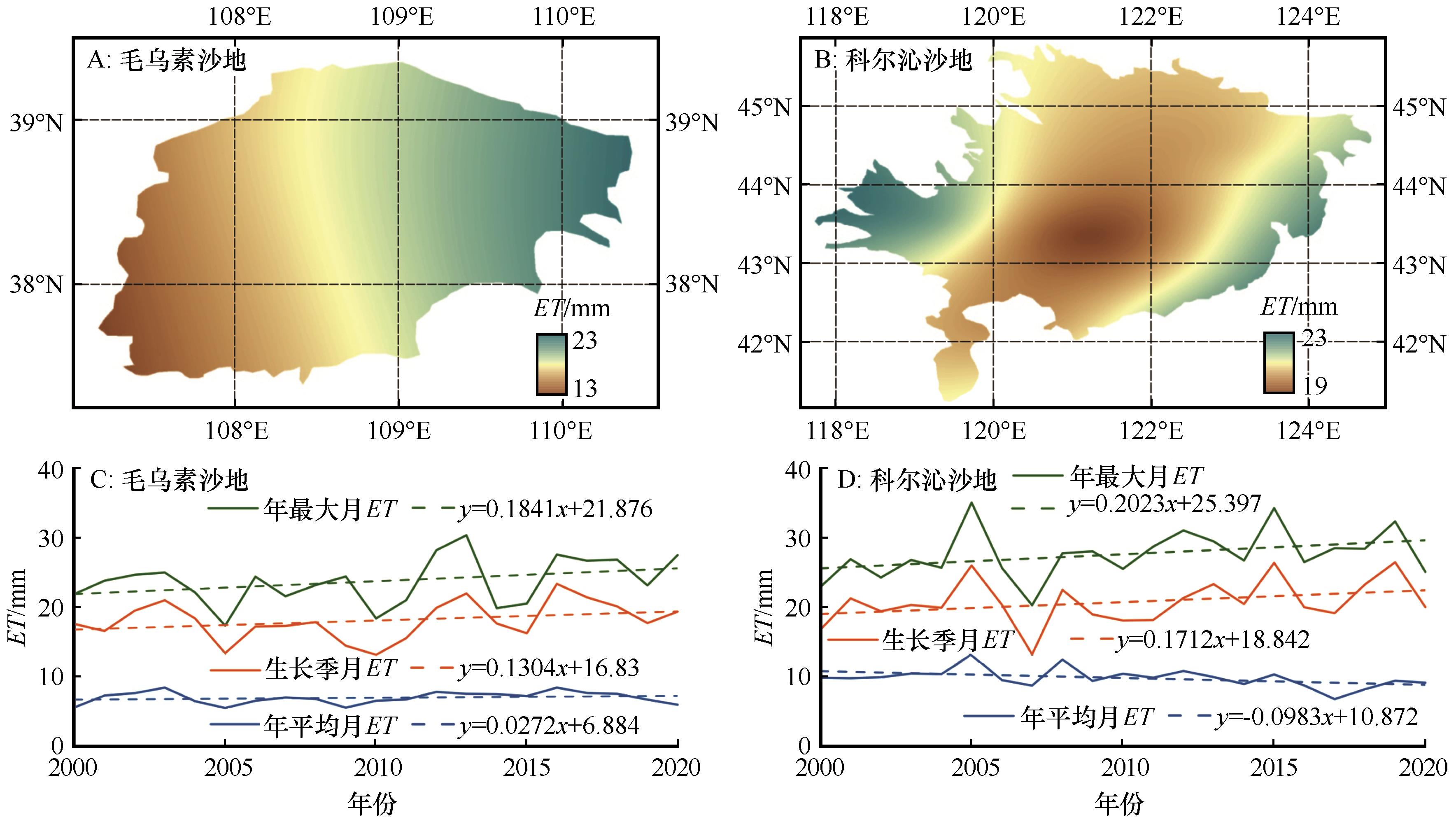
Fig.5 Spatial distribution of multi-year average intra-annual evaporation (ET,A and B), and temporal variation (C and D) in Mu Us Sandy Land and Horqin Sandy Land, 2000-2020
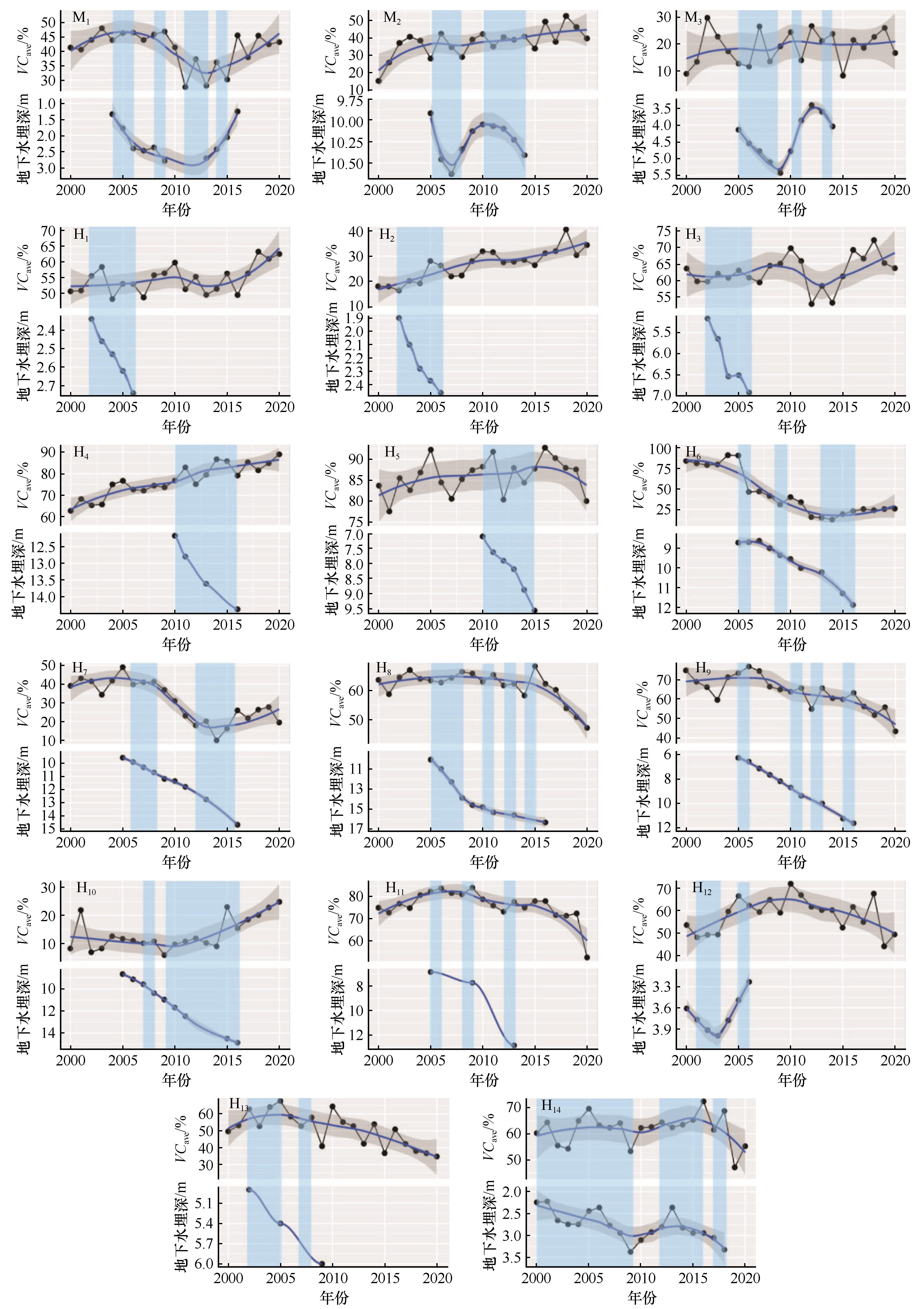
Fig.6 Relationship between average vegetation coverage (VCave) in growing season and groundwater depth in that year of Mu Us Sandy Land and Horqin Sandy Land
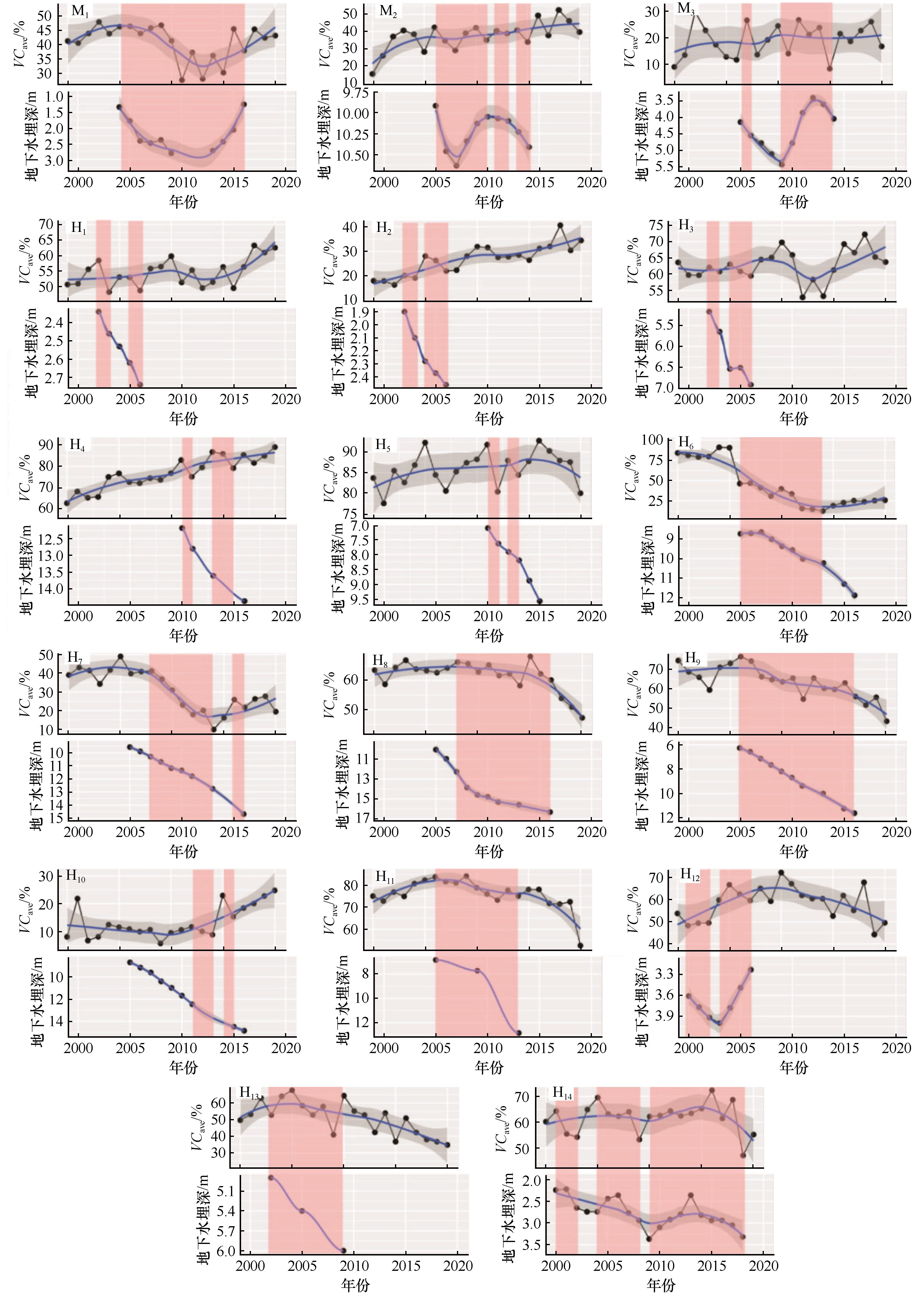
Fig.7 Relationship between average vegetation coverage (VCave) in growing season and groundwater depth in the previous year of Mu Us Sandy Land and Horqin Sandy Land

Fig.8 Dynamic time series of average vegetation coverage (VCave) in the growing season and groundwater variation (GWs) in Mu Us Sandy Land (A) and Horqin Sandy Land (B), 2000-2020
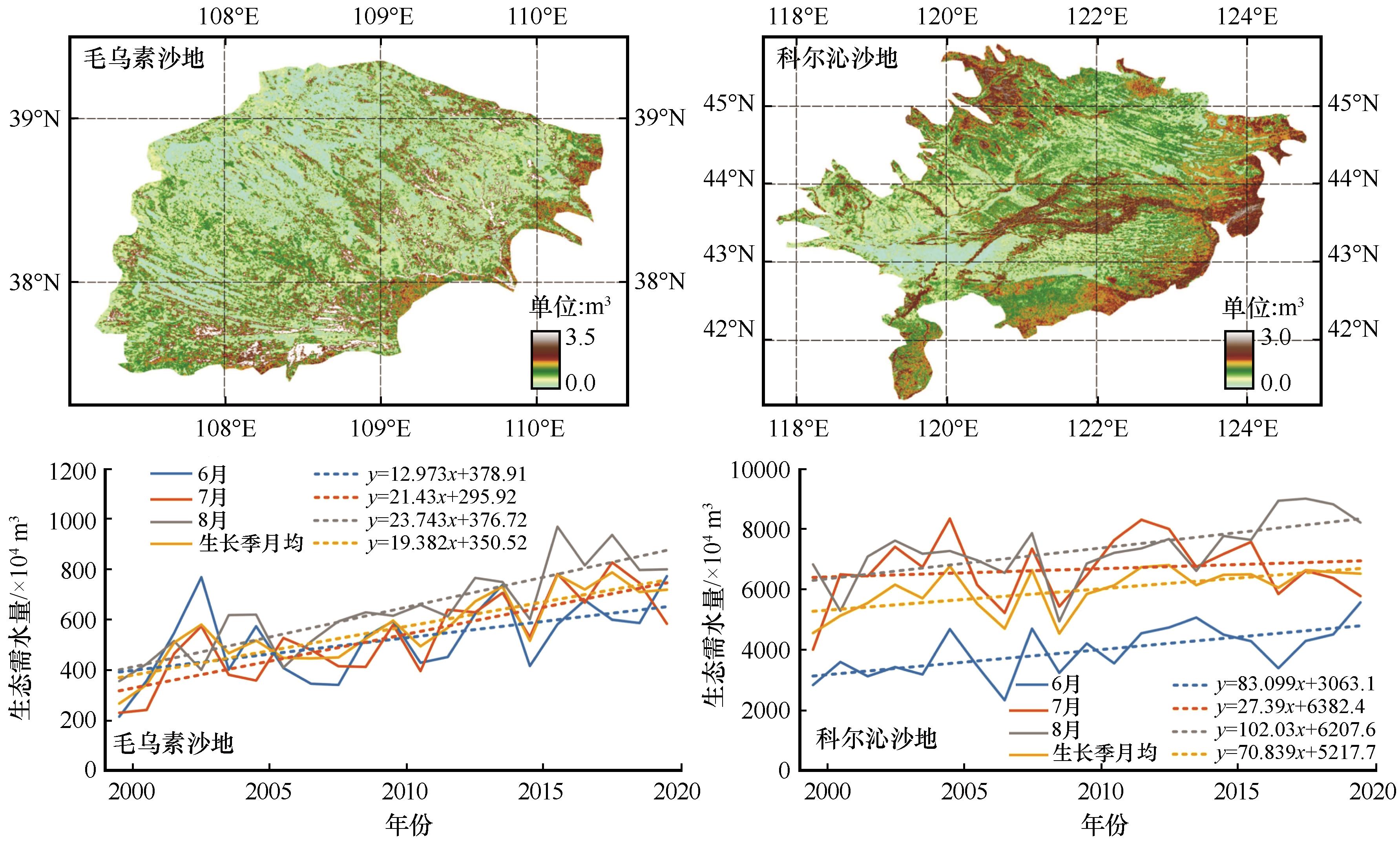
Fig.9 Mean spatial distribution of vegetation water demand (W) in growing season, monthly and monthly average vegetation water demand (W) in growing season in the statistical area unit of Mu Us Sandy Land and Horqin Sandy Land, 2000-2020
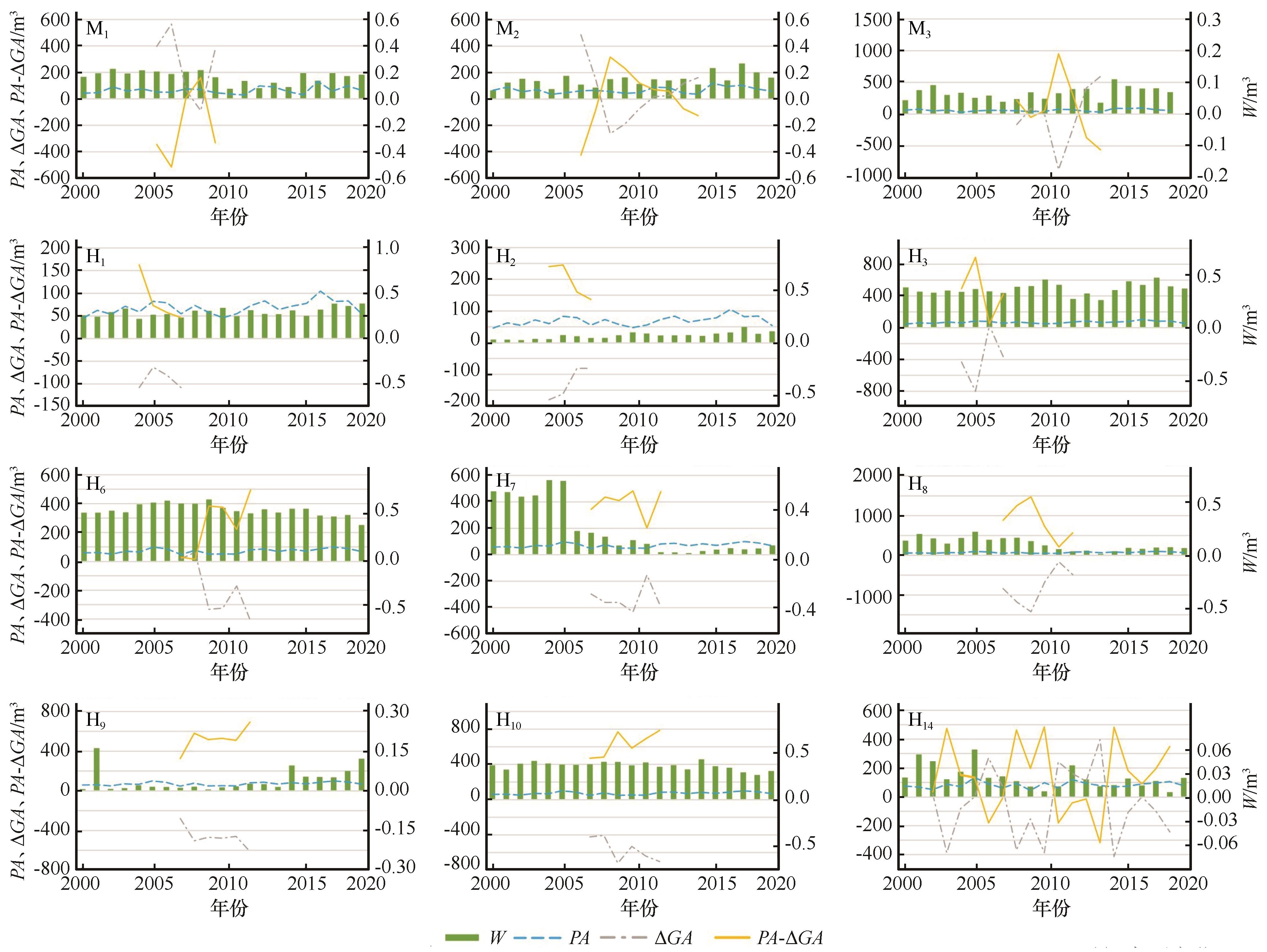
Fig.10 Time series variation of W, PA, ΔGA and PA-ΔGA in the raster buffer cells for observation of Mu Us Sandy Land (M1-M3) and Horqin Sandy Land (H1-H3, H6-H10, H14)

Fig.11 Correlation between W, PA, ΔGA and PA-ΔGA in the raster buffer cells for observation of Mu Us Sandy Land (M1-M3) and Horqin Sandy Land (H1-H3, H6-H10, H14)
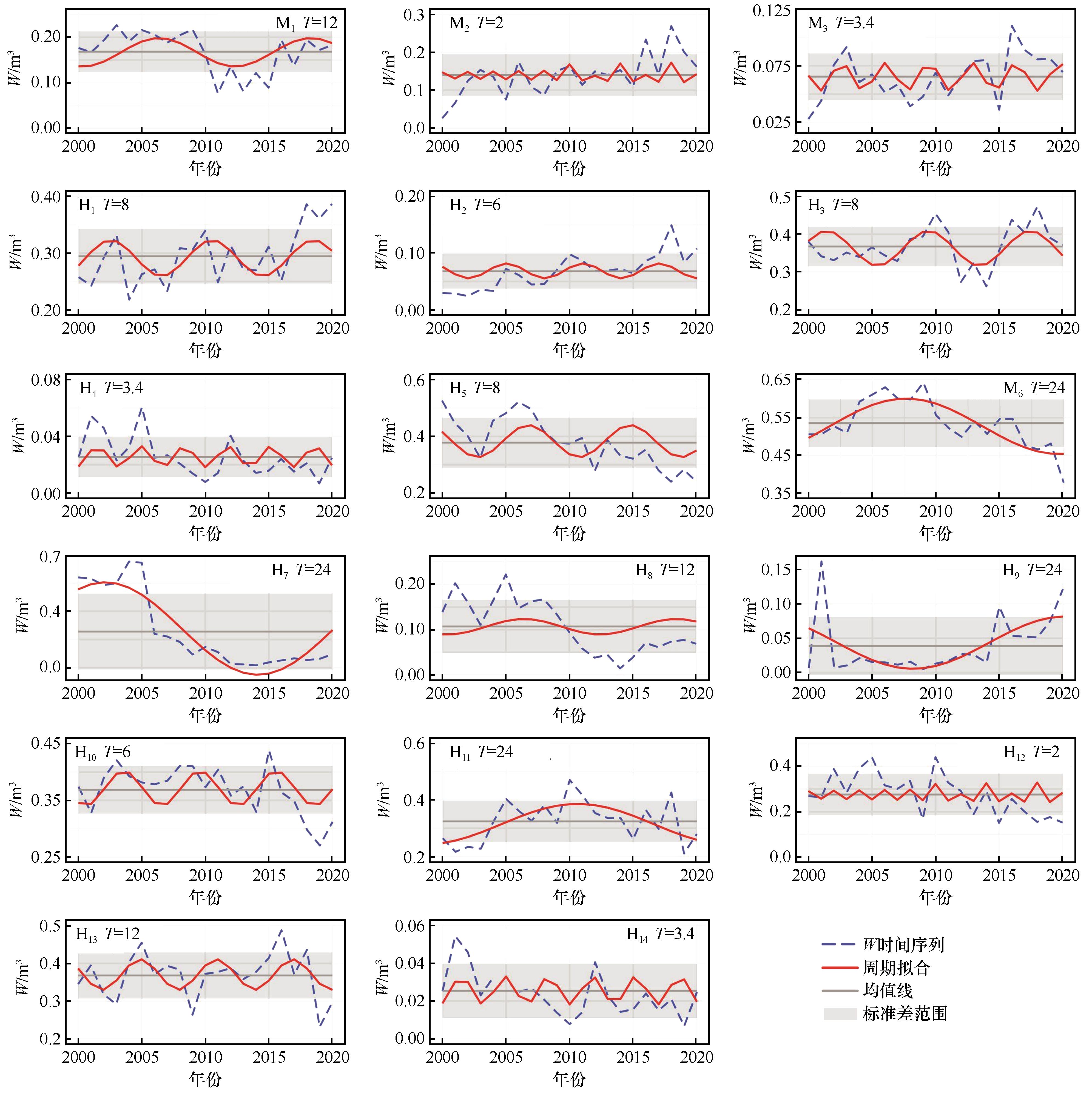
Fig.12 Cyclical fit of vegetation water demand (W) in the growing season of the raster buffer cells for observation in Mu Us Sandy Land and Horqin Sandy Land
| 观测点 | W/m3 | VC/% | P/m3 | 地下水埋深/m |
|---|---|---|---|---|
| M1 | 0.12~0.21 | 37~47 | 40~146 | 1.34~2.81 |
| M2 | 0.10~0.19 | 28~46 | 48~105 | 9.92~10.41 |
| M3 | 0.05~0.09 | 20~27 | 31~108 | 3.40~5.43 |
| H4 | 0.01~0.04 | 76~94 | 51~112 | 12.18~14.37 |
| H5 | 0.29~0.46 | 59~69 | 55~96 | 7.11~9.96 |
| H6 | 0.47~0.60 | 69~80 | 52~97 | 8.64~11.88 |
| H7 | 0.00~0.50 | 11~60 | 52~111 | 9.90~14.68 |
| H8 | 0.05~0.16 | 23~44 | 52~110 | 10.97~15.32 |
| H9 | 0.00~0.08 | 4~24 | 52~110 | 6.26~10.00 |
| H10 | 0.33~0.41 | 60~68 | 52~112 | 8.66~12.46 |
| H11 | 0.25~0.40 | 52~69 | 55~134 | 7.73~12.84 |
| H12 | 0.18~0.37 | 44~63 | 63~120 | 3.61~4.00 |
| H13 | 0.31~0.43 | 53~70 | 65~120 | 4.90~6.00 |
| H14 | 0.01~0.04 | 7~22 | 50~149 | 2.22~3.37 |
Table 1 The range of parameters when the vegetation of raster buffer cells were stable
| 观测点 | W/m3 | VC/% | P/m3 | 地下水埋深/m |
|---|---|---|---|---|
| M1 | 0.12~0.21 | 37~47 | 40~146 | 1.34~2.81 |
| M2 | 0.10~0.19 | 28~46 | 48~105 | 9.92~10.41 |
| M3 | 0.05~0.09 | 20~27 | 31~108 | 3.40~5.43 |
| H4 | 0.01~0.04 | 76~94 | 51~112 | 12.18~14.37 |
| H5 | 0.29~0.46 | 59~69 | 55~96 | 7.11~9.96 |
| H6 | 0.47~0.60 | 69~80 | 52~97 | 8.64~11.88 |
| H7 | 0.00~0.50 | 11~60 | 52~111 | 9.90~14.68 |
| H8 | 0.05~0.16 | 23~44 | 52~110 | 10.97~15.32 |
| H9 | 0.00~0.08 | 4~24 | 52~110 | 6.26~10.00 |
| H10 | 0.33~0.41 | 60~68 | 52~112 | 8.66~12.46 |
| H11 | 0.25~0.40 | 52~69 | 55~134 | 7.73~12.84 |
| H12 | 0.18~0.37 | 44~63 | 63~120 | 3.61~4.00 |
| H13 | 0.31~0.43 | 53~70 | 65~120 | 4.90~6.00 |
| H14 | 0.01~0.04 | 7~22 | 50~149 | 2.22~3.37 |
| 1 | 国家林业局.三北防护林体系建设30年发展报告1978-2008[M].北京:中国林业出版社,2008. |
| 2 | 石莎,邹学勇,张春来,等.京津风沙源治理工程区植被恢复效果调查[J].中国水土保持科学,2009,7(2):86-92. |
| 3 | 李世东.中外退耕还林还草之比较及其启示[J].世界林业研究,2002,15(2):22-27. |
| 4 | Lyu Y L, Shi P J, Han G Y,et al.Desertification control practices in China[J].Sustainability,2020,12(8):3258. |
| 5 | Wang X H, Du Yan, Wang Z R,et al.Dynamic changes of the Mu Us Sandy Land and relevant causes[J].Polish Journal of Environmental Studies,2021,30(4):3815-3827. |
| 6 | Ma Z T, Wang W K, Zhang Z Y,et al.Assessing bare-soil evaporation from different water-table depths using lysimeters and a numerical model in the ordos basin,China[J].Hydrogeology Journal,2019,27:2707-2718. |
| 7 | 卢琦.荒漠生态学[M].北京:中国林业出版社,2019:14-15. |
| 8 | Wang J Y, Gao G Z, Jie D M,et al.Aeolian soils on the Eastern Side of the Horqin Sandy Land,China:a provenance and sedimentary environment reconstruction perspective[J].CATENA,2022,210:105945. |
| 9 | Dai Y, Daiki I, Jeison S,et al.MERIT Hydro:a high-resolution global hydrography map based on latest topography dataset[J].Water Resources Research,2019,55(6):5053-5073. |
| 10 | 赵哈林,赵学勇,张铜会,等.东北西部沙地近20年地下水变化动态及其成因分析[J].干旱区研究,2002,19(2):1-6. |
| 11 | Zhang M M, Wu X Q.The rebound effects of recent vegetation restoration projects in Mu Us Sandy Land of China[J].Ecological Indicators,2020,113:106228. |
| 12 | 格日乐.库布齐沙漠梭梭林地SPAC系统水分关系研究[D].北京:北京林业大学,2005. |
| 13 | 杨小平,梁鹏,张德国,等.中国东部沙漠/沙地全新世地层序列及其古环境[J].中国科学(地球科学),2019,49(8):1293-1307. |
| 14 | 朱震达,吴正,刘恕,等.中国沙漠概论[M].北京:科学出版社,1980. |
| 15 | Yan Q L, Zhu J J, Zheng X,et al.Causal effects of shelter forests and water factors on desertification control during 2000-2010 at the Horqin Sandy Land region,China[J].Journal of Forestry Research,2015,26(1):33-45. |
| 16 | 李宁,周海,任珩,等.不同地下水位处梭梭(Haloxylon ammodendron)水分来源特征[J].中国沙漠,2021,41(4):79-86. |
| 17 | 王根绪,程国栋.干旱荒漠绿洲景观空间格局及其受水资源条件的影响分析[J].生态学报,2000,20(3):363-368. |
| 18 | Horton J, Kolb T E, Hart S C.Physiological response to groundwater depth varies among species and with river flow regulation[J].Ecological Applications,2001,11(4):1046-1059. |
| 19 | Hanjra M, Qureshi M.Global water crisis and future food security in an era of climate change[J].Food Policy,2010,35(5):365-377. |
| 20 | Castle S L, Thomas B F, Reager J T,et al.Groundwater depletion during drought threatens future water security of the Colorado River Basin[J].Geophysical Research Letters,2015,41(16):5904-5911. |
| 21 | 蒋良群,陈曦,包安明.塔里木河下游地下水变化动态分析[J].干旱区地理,2005,28(1):33-37. |
| 22 | Marston L, Konar M, Cai X M,et al.Virtual groundwater transfers from overexploited aquifers in the United States[J].Proceedings of the National Academy of Sciences,2015,112 (28):8561-8566. |
| 23 | Cui L L, Shi J.Evaluation and comparison of growing season metrics in arid and semi-arid areas of northern China under climate change[J].Ecological Indicators,2021,121(10):107055. |
| 24 | 王姣月,秦树高,张宇清.毛乌素沙地植被水分利用效率的时空格局[J].中国沙漠,2020,40(5):120-129. |
| 25 | 王静茹,马龙,刘廷玺.1951-2012年科尔沁沙地气温、降水变化特征[J].干旱区研究,2016,33(1):49-58. |
| 26 | 史文娇,刘奕婷,石晓丽.四个历史时期中国北方农牧交错带界线数据集(1970-2010)[J].全球变化数据学报(中英文),2018,2(4):419-425. |
| 27 | 刘志民,余海滨.“山水林田湖草沙生命共同体”理念下的科尔沁沙地生态治理[J].中国沙漠,2022,42(1):34-40. |
| 28 | 石书兵.中国沙漠·沙地·沙生植物[M].北京:中国农业科学技术出版社,2013. |
| 29 | 国家林业和草原科学数据中心.三北防护林体系建设总体规划四期工程[EB/OL].[2024-04-10].. |
| 30 | 国家林业和草原局.中国退耕还林还草20年(1999-2019)[EB/OL].[2024-04-10].. |
| 31 | 王旭升,尹立河,方坤,等.鄂尔多斯浩勒报吉水源地开采地下水的环境影响分析[J].水文地质工程地质,2019,46(2):5-12. |
| 32 | 郑玉峰,王占义,方彪,等.鄂尔多斯市2005-2014年地下水位变化[J].中国沙漠,2015,35(4):1036-1040. |
| 33 | 赵玮,张铜会,赵学勇,等.近5 a来科尔沁沙地典型区域地下水埋深变化分析[J].中国沙漠,2008,28(5):995-1000. |
| 34 | 中国地质环境监测院.中国地质环境监测地下水位年鉴:2006[M].北京:中国大地出版社,2007. |
| 35 | 中国地质环境监测院.中国地质环境监测地下水位年鉴:2007[M].北京:中国大地出版社,2008. |
| 36 | 中国地质环境监测院.中国地质环境监测地下水位年鉴:2008[M].北京:中国大地出版社,2009. |
| 37 | 中国地质环境监测院.中国地质环境监测地下水位年鉴:2010[M].北京:中国大地出版社,2011. |
| 38 | 中国地质环境监测院.中国地质环境监测地下水位年鉴:2011[M].北京:中国大地出版社,2012. |
| 39 | 中国地质环境监测院.中国地质环境监测地下水位年鉴:2013[M].北京:中国大地出版社,2014. |
| 40 | 中国地质环境监测院.中国地质环境监测地下水位年鉴:2015[M].北京:中国大地出版社,2018. |
| 41 | Syed T H, Famiglietti J S, Matthew R,et al.Analysis of terrestrial water storage changes from GRACE and GLDAS[J].Water Resources Research,2008,44:W02433. |
| 42 | Cheung M W, Vijayakumar R.A guide to conducting a meta-analysis[J].Neuropsychol Review,2016,26(2):121-128. |
| 43 | 张高强.乌审召盆地植被、蒸散与地下水的相互关系研究[D].北京:中国地质大学(北京),2019. |
| 44 | Rohatgi,Ankit.WebPlotDigitizer user manual version 3.4[Z].http://arohatgi.info/WebPlotDigitizer/app:1-18. |
| 45 | 卜凡蕊,刘颖,邹学勇.中国东部典型沙地植被覆盖度对降水变化的响应[J].中国沙漠,2023,43(3):9-20. |
| 46 | Hargreaves G H, Samani Z A.Estimation of potential evapotranspiration[J].Journal of Irrigation and Drainage Division,1982,108(3):223-230. |
| 47 | 傅抱璞.论陆面蒸发的计算[J].大气科学,1981,5(1):23-31. |
| 48 | 王忠静,张子雄,索滢.干旱区凝结水评估及对水量平衡方程影响[J].水利学报,2019,50(6):710-720. |
| 49 | Churchill R V.Fourier Series and Boundary Value Problems[M].Now York,USA.McGraw-Hill,1963:322. |
| 50 | 李河.陕北榆林毛乌素沙地新开垦耕地空间分布特征:以靖边县为例[J].安徽农业科学,2021,49(21):79-81. |
| 51 | Lian J, Zhao X Y, Li X,et al.Detecting sustainability of desertification reversion:vegetation trend analysis in part of the agro-pastoral transitional zone in Inner Mongolia,China[J].Sustainability,2017,9(2):211. |
| 52 | Zhang G Q,Cheng,Y T, Liu H D,et al.Evaluation of the groundwater ecological water requirement in the southeast margin of otindag sandy land based on allowable groundwater depth drawdown[J].Water,2023,15(19):3504. |
| 53 | Zheng X, Zhu J J, Yan Q L,et al.Effects of land use changes on the groundwater table and the decline of pinus sylvestris var.mongolica plantations in southern Horqin Sandy Land,Northeast China[J].Agricultural Water Management,2012,109:94-106. |
| 54 | 张本兴,潘云,李小娟.中国不同气候区域Hargreaves模型的修正[J].地理与地理信息科学,2012,28(1):51-54. |
| 55 | Bao Y Z, Liu T X, Duan L M,et al.Comparison of an improved Penman-Monteith model and SWH model for estimating evapotranspiration in a meadow wetland in a semiarid region[J].The Science of the Total Environment,2021,795:148736. |
| 56 | Ngongondo C, Xu C, Tallaksen L,et al.Evaluation of the FAO Penman-Montheith,Priestley-Taylor and Hargreaves models for estimating reference evapotranspiration in southern Malawi[J].Hydrology Research,2013,44(4):706-722. |
| 57 | Meyer W S, Kondrlova G R, Koerber G R.Evaporation of perennial semi-arid woodland in southeastern Australia is adapted for irregular but common dry periods[J].Hydrological Processes,2015,29(17):3714-3726. |
| 58 | Zhang L, Hickel K, Dawes W R,et al.A Rational Function Approach for Estimating Mean Annual Evapotranspiration[J].Water Resources Research,2004,40(2):W02502. |
| 59 | Cheng C W, Liu W Z, Mu Z T,et al.Lumped variable representing the integrative effects of climate and underlying surface system:interpreting Budyko model parameter from earth system science perspective[J].Journal of Hydrology,2023,620:129379. |
| 60 | 韩松俊,胡和平,田富强.基于水热耦合平衡的塔里木盆地绿洲的年蒸散发[J].清华大学学报(自然科学版),2008,48(12):2070-2073. |
| 61 | Bian Y M, Dai H Y, Zhang Q L,et al.Spatial distribution of potential evapotranspiration trends in the Inner Mongolia Autonomous Region (1971-2016)[J].Theoretical and Applied Climatology,2020,140(3/4):1161-1169. |
| 62 | Zhang Y Q, Peña-Arancibia J L, McVicar T R,et al.Multi-decadal trends in global terrestrial evapotranspiration and its components[J].Scientific Reports,2016,6(1):19124. |
| 63 | 李小文,王祎婷.定量遥感尺度效应刍议[J].地理学报,2013,68(9):1163-1169. |
| 64 | Zhang Y Q, Kong D D, Gan R,et al.Coupled estimation of 500 m and 8-day resolution global evapotranspiration and gross primary production in 2002-2017[J].Remote Sensing of Environment,2019,222:165-182. |
| 65 | Mao D H, Wang Z M, Wu B F,et al.Land degradation and restoration in the arid and semiarid zones of China:quantified evidence and implications from satellites[J].Land Degradation Development,2018,29(11):3841-3851. |
| [1] | Jing Zhang, Xiaoan Zuo, Peng Lv. Effects of changes in growing season precipitation regimes on plant community structure, function and aboveground biomass in typical habitats in the Horqin Sandy Land [J]. Journal of Desert Research, 2024, 44(4): 1-13. |
| [2] | Rong Zhu, Zejian Ao, Youyan Jiang. Assessment of ecological environment vulnerability in Tianshui city based on the CRITIC objective weighting method [J]. Journal of Desert Research, 2024, 44(3): 321-331. |
| [3] | Xiaohu Kang, Lin Li, Chao Sun, Hu Liu. Evaluation of groundwater sustainability in the Yellow River Basin of Gansu Province using GRACE and GLDAS Data Products [J]. Journal of Desert Research, 2024, 44(2): 196-206. |
| [4] | Jialong Ren, Jiliang Liu, Yongzhen Wang, Jing Fang, Yilin Feng, Anling Gao, Yuanxia Song, Weidong Xin. Response of ground arthropod assemblages to precipitation and temperature changes in the gobi desert [J]. Journal of Desert Research, 2024, 44(2): 207-219. |
| [5] | Jing Zhang, Xiaoan Zuo, Peng Lv. Effects of nutrient and water content on leaf nitrogen recovery efficiency of dominant plants in sandy grasslands [J]. Journal of Desert Research, 2024, 44(1): 161-169. |
| [6] | Yajuan Zhu, Chenguang Zhao, Huiying Li, Aqing Wang. The favorable conditions for germination of four shrubs with air seeding on east Alxa Plateau [J]. Journal of Desert Research, 2024, 44(1): 96-101. |
| [7] | Yongpeng Wang, Alimujiang, Long Zhou, Pengnian Yang, Siyang Feng, Yanwen Wang. Ecological water conveyance effect in the lower reaches of Tarim River [J]. Journal of Desert Research, 2023, 43(4): 231-240. |
| [8] | Yayi Niu, Wei Liu, Jiarui Dong, Jie Lian, Xuyang Wang, Yuqing Li. The variation characteristics of main meteorological factors in Horqin Sandy Land during 1961-2021: A case study of Naiman Banner [J]. Journal of Desert Research, 2023, 43(4): 263-273. |
| [9] | Fanrui Bu, Ying Liu, Xueyong Zou. Response of vegetation coverage to precipitation change in the typical sandy lands of eastern China [J]. Journal of Desert Research, 2023, 43(3): 9-20. |
| [10] | Yunjie Huang, Yonggang Li, Benfeng Ying, Yuanming Zhang. Response of nitrogen and phosphorus stoichiometry in Syntrichia caninervis to annual precipitation [J]. Journal of Desert Research, 2023, 43(2): 1-10. |
| [11] | Lingfei Zhong, Lihua Zhang. Changes in temperature and precipitation in the plain area of Hexi Corridor in 2000-2020 [J]. Journal of Desert Research, 2023, 43(2): 264-270. |
| [12] | Aihua Hao, Xian Xue, Quangang You, Chaoyang Gou. Review on precipitation change over the Qinghai-Tibetan Plateau in recent 60 years [J]. Journal of Desert Research, 2023, 43(2): 43-52. |
| [13] | Qi Zhang, Yonghong Su, Qi Feng, Tengfei Yu, Xiaohong Ma. Estimation of groundwater evapotranspiration of Populus euphratica forest ecosystem along desert river banks based on groundwater level dynamics [J]. Journal of Desert Research, 2022, 42(6): 243-254. |
| [14] | Lin Li, Hu Liu, Chengpeng Sun, Wenzhi Zhao. Groundwater evapotranspiration estimation based on soil moisture and water table measurements [J]. Journal of Desert Research, 2022, 42(6): 277-287. |
| [15] | Junjie Wang, Bing Shi, Tao Bai, Qingyun Yuan. Spatio-temporal patterns of precipitation and its possible driving factors in the Yellow River Basin [J]. Journal of Desert Research, 2022, 42(6): 94-102. |
| Viewed | ||||||
|
Full text |
|
|||||
|
Abstract |
|
|||||
©2018Journal of Desert Research
Tel:0931-8267545
Email:caiedit@lzb.ac.cn;desert@lzb.ac.cn
Support:Magtech